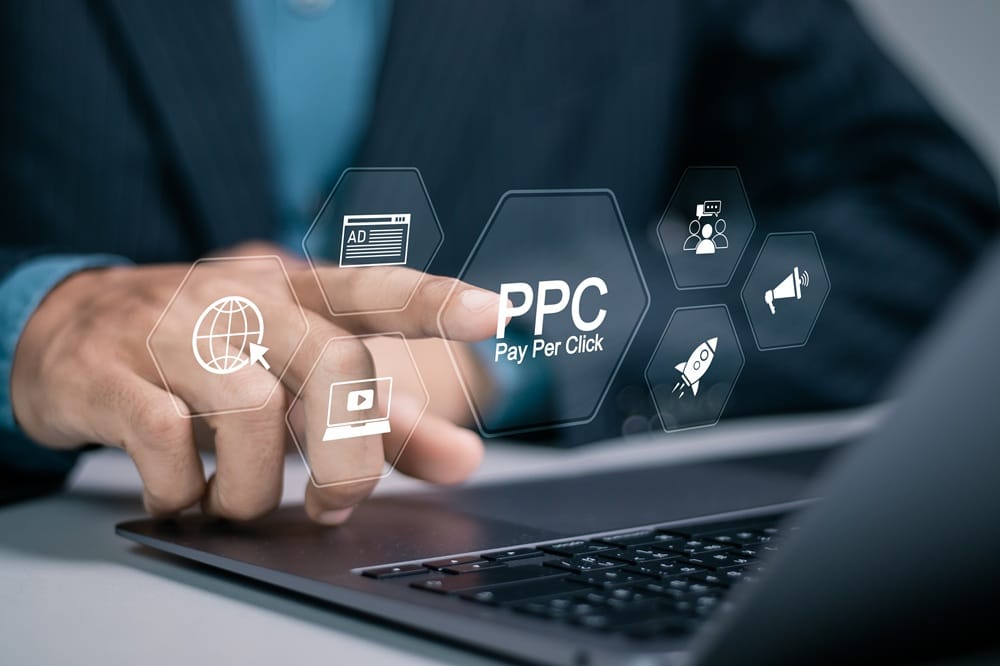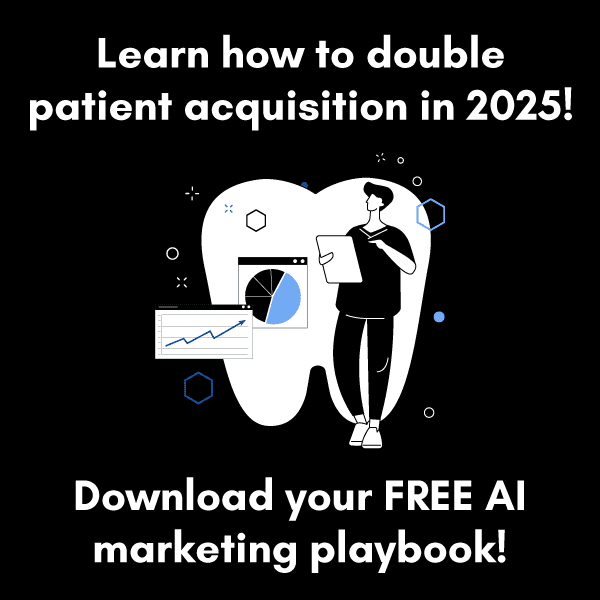
Author: Jesse Davis | Co-Founder & CEO of ViziSites
Table of Contents
Key Takeaways
- Dental PPC delivers immediate visibility at the top of search results, allowing you to capture high-intent patients exactly when they’re searching for dental services.
- Geographic targeting lets you show ads only within your service radius, ensuring every dollar spent targets potential patients who can actually visit your practice.
- A well-managed PPC campaign typically costs $50-150 per new patient acquisition, with successful practices investing 2-4% of annual revenue in marketing.
- Platform diversification is crucial – while Google Ads captures urgent searches, Facebook and Instagram excel at demographic targeting for specific services like pediatric or cosmetic dentistry.
- HIPAA compliance requires careful handling of patient data in digital marketing, including generic retargeting messages and written consent for any patient imagery or testimonials.
You’ve invested years perfecting your clinical skills, yet your appointment book has more gaps than a seven-year-old’s smile. While you’re waiting for the phone to ring, your competitors are capturing patients searching online for “dentist near me” – patients who should be calling your practice instead.
Here’s the harsh reality: 97% of consumers search online for local services, and if your practice doesn’t appear at the top of those search results, you’re invisible.
Traditional marketing like Yellow Pages ads and mailers end up in recycling bins, while dental PPC campaigns put your practice directly in front of patients at the exact moment they’re ready to book. This guide reveals how to transform your online presence from invisible to irresistible, filling your schedule with quality patients who actually show up.

Understanding Dental PPC Advertising
What Is PPC and Why Should You Care?
Let’s start with the basics. When you run PPC ads for your dental practice, you’re essentially buying a spot at the top of search results. You only pay when someone actually clicks on your ad – not just when they see it.
Think of it this way: when someone types “emergency dentist near me” into Google at 2 AM with a throbbing toothache, your ad can appear right at the top, above all the organic results. That’s the power of dental PPC – you’re there exactly when patients need you most.
Why PPC Works So Well for Dental Practices
Here’s what makes PPC advertising a game-changer for dentists:
- Instant Visibility
- Your PPC ads can start bringing in patients today
- Jump straight to the top of search results
- No waiting months for SEO to work
- Laser-Targeted Reach
- Target moms within 5 miles for pediatric services
- Reach adults 45-65 who need implants
- Only pay for clicks from your service area
- Complete Transparency
- Track every click, call, and appointment
- Know exactly which ads bring in patients
- Calculate your real cost per new patient
Geographic precision means every dollar targets someone who could actually sit in your chair. Draw a circle around your practice and show ads only to people there – dramatically reducing your patient acquisition cost.

Setting Up Your Dental PPC Strategy
Define What Success Looks Like
Before spending a single dollar, get clear on your goals:
For New Patients:
- Set specific targets: “20 new patient exams per month”
- Track your current baseline first
- Measure against monthly goals
For Service Promotion:
- “5 Invisalign consultations per month”
- “Fill all Saturday appointment slots”
- “10 teeth whitening appointments”
These concrete numbers help you determine if your digital marketing strategy is working and control your dentist marketing spend effectively.
Finding the Right Keywords Without Breaking the Bank
Keywords are the foundation of dental PPC success:
High-Intent Keywords (ready to book):
- “dentist near me”
- “emergency dentist open now”
- “[your city] dental office”
Service-Specific Keywords (targeting needs):
- “Invisalign dentist [city]”
- “wisdom teeth removal cost”
- “same day dental crowns”
Long-Tail Keywords (lower cost):
- “Saturday dentist downtown [city]”
- “dentist who takes Delta Dental PPO”
- “gentle dentist for anxious patients”
Mix broad terms with specific ones. Longer searches usually cost less and bring in patients who know exactly what they want.
Competitive Analysis Made Simple
Research your competition effectively:
- Google your services – Note which ads appear
- Analyze their messaging – What offers do they make?
- Check their landing pages – How’s the user experience?
- Find your unique angle – What can you offer that’s different?
Understanding the average dental advertising budget in your area helps you compete without overspending.

Platform-Specific Implementation
Campaign Setup Basics (All Platforms)
Regardless of platform, follow these fundamentals:
Campaign Structure:
- Separate campaigns by service type
- Set daily budgets for each
- Use location targeting precisely
- Track conversions properly
Essential Elements:
- Clear headlines matching search intent
- Strong calls-to-action
- Phone numbers and addresses
- Trust signals (reviews, certifications)
Google Ads: Your New Patient Pipeline
Google Search ads capture high-intent patients actively looking for dental services.
Key Google Features:
- Call Extensions: Mobile users tap to call
- Location Extensions: Show your address
- Review Extensions: Display star ratings
- Local Services Ads: Pay per lead, not click
Focus your Google budget on emergency and immediate-need searches where intent is highest.

Social Media: Facebook and Instagram
Facebook and Instagram excel at demographic targeting and visual storytelling.
Best Uses:
- Target parents for pediatric services
- Showcase cosmetic transformations
- Build community awareness
- Retarget website visitors
Content That Works:
- Team member spotlights
- Patient success stories (with permission)
- Educational posts
- Subtle special offers
Keep social ads conversational and relationship-focused rather than hard-selling.

Bing: The Hidden Opportunity
Don’t overlook Bing’s potential:
- 7% market share with older, insured users
- Lower competition means cheaper clicks
- Import Google campaigns in minutes
- Allocate 10-20% of budget to test
Many practices get quality leads at half Google’s cost.

Writing Ads That Get Clicks
Headlines That Work
Skip generic phrases and speak to patient needs:
- Instead of: “Quality Dental Care”
Try: “Finally, Same Day Appointments Available”
- Instead of: “Experienced Team”
Try: “Nervous? We Specialize in Anxious Patients”
Focus on benefits, not features. Patients care about solutions, not equipment.
Effective Calls-to-Action
Every ad needs a clear call-to-action:
Emergency: “Call Now for Same-Day Relief”
Cosmetic: “See Your New Smile – Free Consultation”
General: “Book Online in 30 Seconds”
Match urgency to service type and platform.
Address Dental Anxiety
Use reassuring language:
- Gentle, comfortable, understanding
- Mention sedation options
- Highlight comfort amenities
- Build trust through empathy
Local Relevance Matters
Include location signals:
- Neighborhood names
- Nearby landmarks
- “Serving [Area] Since [Year]”
- Local references
This improves relevance and reduces marketing spend.

Advanced Targeting Techniques for Dental PPC
Geographic Precision
Set smart boundaries:
General Dentistry:
- Urban: 3-5 miles
- Suburban: 5-10 miles
- Rural: 10-20 miles
Bid by Distance:
- 0-3 miles: +20% adjustment
- 3-7 miles: Normal bids
- 7+ miles: -20% adjustment
Demographic Targeting by Service
Match targeting to services:
Cosmetic: Ages 25-54, higher income
Pediatric: Parents with young children
Implants: Ages 45+, steady income
Smart Retargeting
Keep it general and HIPAA-compliant:
- “We’re here when you’re ready”
- “Still need that root canal?”
Set frequency caps and exclude converted patients.

Budget Planning and Optimization
Setting Realistic Budgets
Industry Standards:
- Marketing: 2-4% of revenue
- PPC: 50-70% of marketing budget
- Monthly minimum: $1,000-2,500
Example ($1M practice):
- Annual revenue: $1,000,000
- Marketing (3%): $30,000
- PPC (60%): $1,500/month
Bidding Strategies
Manual (beginners): Control costs while learning
Target CPA (conversions): Set desired cost per patient
Maximize Conversions (volume): Fill schedules fast
Platform Distribution
Start with:
- Google Search: 60%
- Facebook/Instagram: 20%
- Retargeting: 10%
- Bing: 10%
Adjust based on performance data.

Staying Legal and Ethical
Truth in Advertising
Avoid:
- Unverifiable claims (“best dentist”)
- Guarantees you can’t keep
- Misleading pricing
- False credentials
Use:
- Factual statements
- Real patient numbers
- Transparent pricing
- Verifiable claims
HIPAA Compliance
Always:
- Get written consent for patient content
- Keep retargeting messages general
- Train staff on privacy
- Document compliance
Never:
- Use photos without consent
- Confirm patient status publicly
- Target based on health conditions
Platform Policies
Each platform has unique healthcare rules. Learn them before creating ads to avoid rejections.

Tracking Success
Key Metrics
Focus on what matters:
Primary KPIs:
- Cost Per Click (CPC)
- Click-Through Rate (2-5% target)
- Conversion Rate (10%+ is good)
- Cost Per Acquisition ($50-150 typical)
Quality Score Impact:
- 7-10: Great, low costs
- 4-6: Needs improvement
- 1-3: Fix immediately
ROI Calculation
Track Return on Ad Spend:
- Revenue ÷ Ad Spend = ROAS
- Example: $5,000 ÷ $1,000 = 5:1
- Include lifetime patient value

Optimization Strategies
A/B Testing Essentials
Test one element at a time:
- Headlines
- CTAs
- Images
- Landing pages
Run tests for 2+ weeks for statistical significance.
Dayparting
Optimize by time:
- Lunch hours: Higher bids
- After hours: Emergency only
- Weekends: Adjust by service

Device Optimization
Mobile: Click-to-call, fast loading
Desktop: Detailed info, easy navigation
Track and optimize separately.

Campaign Types by Specialty
Emergency Dental
Focus: Immediate availability
Message: “See us TODAY”
Strategy: 24/7 campaigns, high bids
Success factor: Fast phone response
Cosmetic Dentistry
Focus: Visual results
Message: “Transform your smile”
Strategy: Education, financing options
Success factor: Before/after galleries
Pediatric Dentistry
Focus: Parent concerns
Message: “Kids love coming here”
Strategy: Target parents, seasonal timing
Success factor: Comfort features

Frequently Asked Questions
How much should we spend on PPC?
Start with 2-4% of revenue on marketing, allocating 50-70% to PPC. A $1M practice might spend $1,000-2,500 monthly on PPC.
Which platform is best?
Google Ads captures high-intent searches. Facebook targets demographics. Use both for comprehensive coverage.
When will we see results?
Clicks start immediately, but optimization takes 2-3 months for best ROI.
What's a good cost per patient?
$50-150 is typical. Compare to lifetime value – if patients average $1,500 first-year revenue, $100 acquisition cost is profitable.
Agency or DIY?
Start yourself to learn, then consider an agency as you grow. Agencies charge 10-20% of spend plus fees.
How do we track calls?
Use call tracking numbers and duration tracking to identify quality leads.
What about HIPAA?
Get written consent for patient content. Keep retargeting generic. Never use health conditions for targeting.
How often should we optimize?
Check weekly, make meaningful changes monthly, refresh creative quarterly.

Conclusion
You now have everything needed to transform empty appointment slots into a thriving, fully-booked dental practice. PPC advertising brings measurable returns when done right.
Start with clear goals, choose platforms where your patients spend time, and create messages addressing their concerns. Begin small, test what works, and scale successes. Your future patients are searching right now – make sure they find you, not competitors. With smart optimization, dental PPC becomes a reliable growth engine, turning marketing investment into a full patient schedule.

About the Author:
Jesse Davis
Co-Founder & CEO of ViziSites
Jesse has been on the cutting edge of healthcare marketing for two decades, first catapulting iMatrix from a handful of clients to thousands of practice owners by building high-performance teams and forging strategic partnerships, then launching the veterinary division at ProSites and providing a foundation that scaled it nationally. Today he leads ViziSites, where he and his team harness a “tsunami” of AI-driven data to turn complex signals into clear, measurable growth for practice owners nationwide. A 4th-degree Brazilian Jiu-Jitsu black belt and outspoken mentor, Jesse channels the same discipline from the mat into empowering young founders and helping thousands of practices dominate local search while demystifying the future of AI in practice marketing.










